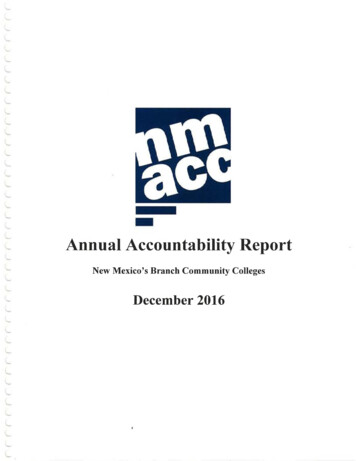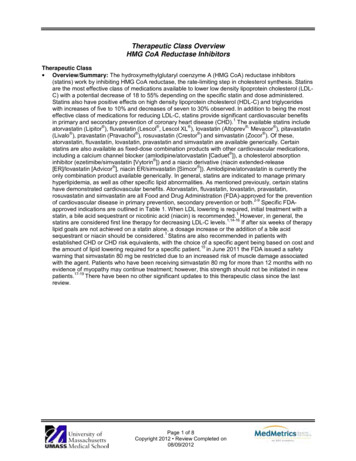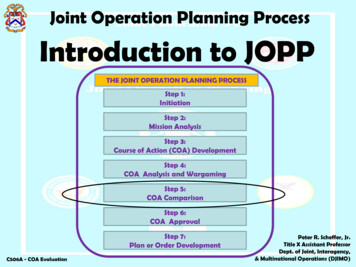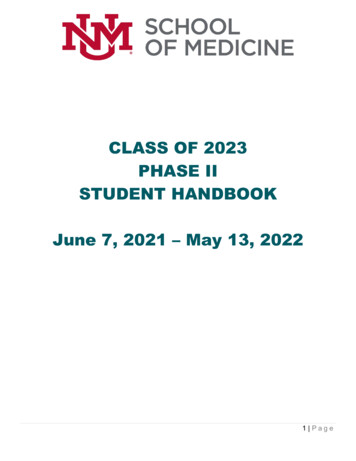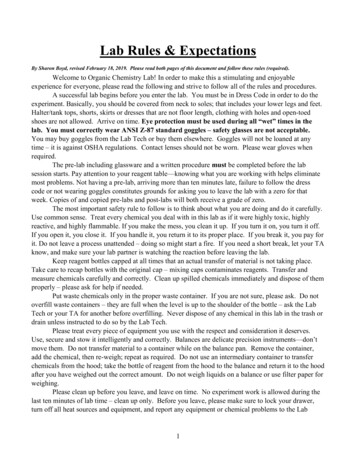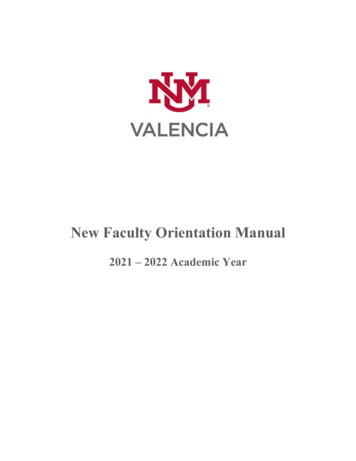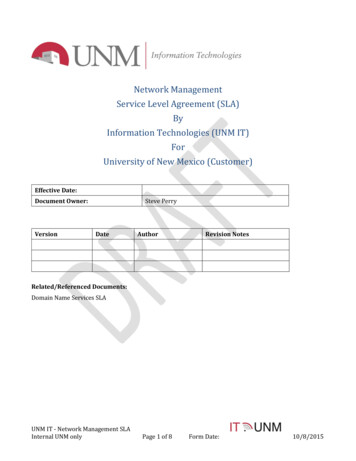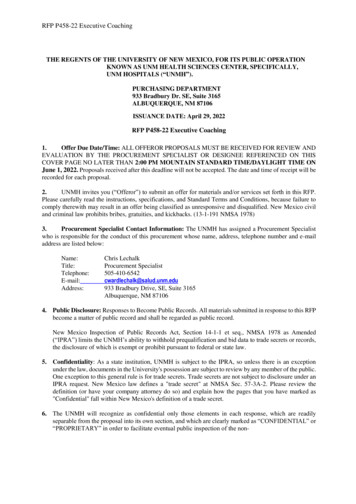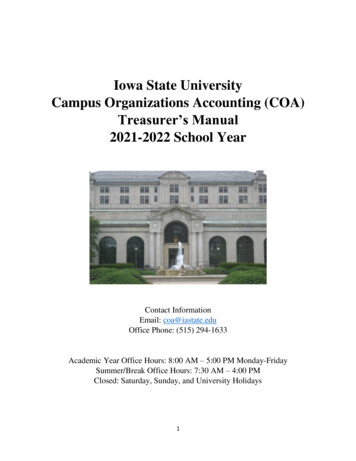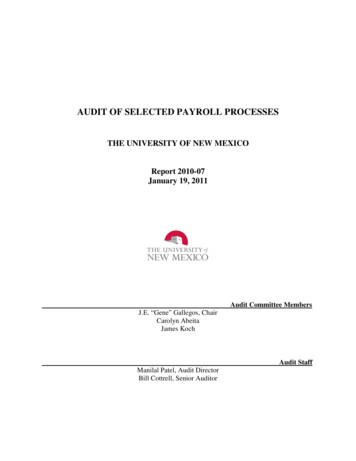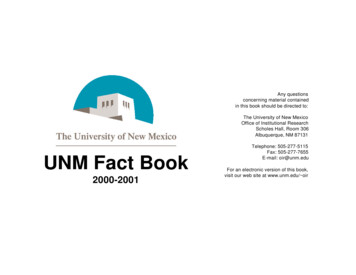
Transcription
IN THE COURT OF APPEALS OF THE STATE OF NEW MEXICOCOURT OFA PE,LsDFNEwMExIcoALUCUEROUEFILEDKIMBERLY MONTAO,SEP 1 5 2014Plaintiff-Ap pcI I Ce,No. 32.403vs.ELDO FREZZA, M.D., andLOVELACE INSURANCE COMPANY,a domestic for-profit Corporaton,Defendants-Appellants.ON PETITION FOR WRIT OF ERROR TO THE SECOND JUDICIAl.DISTRICT COURT OF THE STATE OF NEW MEXICOPLAINTIFF-APPELLEE’S CORRECTED ANSWER BRIE FSubmitted by:Jerry Todd WertheimRoxie De SantiagoSamuel C. WolfElizabeth C. CliffordJones. Snead, Wertheim & Clifford, P.A.P.O. Box 2228Santa Fe. NM 87504-2228(505) 982-001 1A ttornevs far Plaintif[AppclleeKim benT Mon taio
TABLE OF CONTENTSTLEOFAUThORIES.iiSTATEMENT OF THE CASE AND SUMMARYoF PIX)(DEEI)I1’1(3S1II.SUMMARYOF THE ARGUMENT2iii.RcilJrvtEl’rr144a.The Collateral Order Doctrine is Inappropriate andInapplicablellereI.ii.iii.b.c.IV.4The Order here does not finally determine thedisputed question6The issues addressed in Judge Bacon’s Orderare Directly Tied to the Merits of Ms. Montafto’scase and the Writ of Error is therefore inappropriate7Dr. Frezza has an effective remedy to any wrongthrough direct appeal of any judgment entered inthis action, and the collateral order doctrine istherefore notproperhere9The “Place ofthe Wrong” Rule, Properly Construed,Requires that New Mexico have Jurisdiction overDr. Frezza9The Doctrine of Comity Requires that the Present Suitbe 1—Jeard in New Iviexico11CONCLUSION18
TABLE OF AUTHORITIESNew Mexico CasesCampos de Sueflos, Ltd. v. County of Bernalillo, 2001-NMCA-043,130 N.M. 563.28 P. 3d 11042, 10. 11Carillo v. Rostro. 114 N.M. 607. 845 P. 2d 130 (1992)Flemma v. Halliburton Energy Services, Inc., --P. 3d,23538328--.2013 WLHandmaker v. Hennev. i999-NMSC-043. 128 N.M. 328.992 P. 2d 879 (1999)Sam v. Sam, 2006-NMSC-022, 139 N.M. 474. 134 P. 3d 761Santa Fe Technologies. Inc. v. Argus Networks. Inc.2002-NMCA-030, 131 N.M. 772,42 P. 2d 1221Terrazas v. Garland & Lornan. Inc., 2006-NMCA-1 11. 140 N.M. 293,142P.3d37464,5, 8,9passirn5-69New Mexico StatutesNMSA 1978.41-4-1 et. seq5. 14Texas CasesState of New Mexico v. Caudle, 108 S.W. 3d 319 (Tex. App.2002)12, 15Texas StatutesV.T.C.A.§101.001 el seq12, 13. 15PublicationsThe Business of Surgery, Cine-Med 20071,2. 17
LSTATEMENT OF THE CASE AND SUMMARY OF PROCEEDINGSThe core of Ms. Kimberly Montaflo’s allegations in this case, and theultimate source of her significant injuries, is a contractual arrangement betweenLovelace Insurance Company r’Lovelace”), a New Mexico corporation; TexasTech Physicians Associates (“lTPA”), a physicians’ practice group in Lubbock,Texas; and Dr. Eldo Frezza, a member of TTPA. [RP-189-0190] Sadly, it mustalso be noted that this is only one of several similar cases: the undersignedrepresent four individuals who suffered severe and permanent harm on Dr.Frezza’s operating table under similar circumstances, and are aware of dozens ofother victims of Dr. Frezza’s negligence.Under the contractual arrangementbetween Lovelace and TTPA (and a similar agreement between FlEA andPresbyterian Insurance Company), Ms. Montaflo and others were informed that ifthey needed bariatric surgery, they had two choices: see Dr. Frezza in Lubbock, orpay for the surgery themselves. [RP000I -0004]Dr. Eldo Frezza is an Italian surgeon who has written a book and numerousarticles advising physicians on how to increase their revenue. [RPO 109-0114] Hewas also a member of the flPA, the private practice group that worked for thebenefit of its physician members; Dr. Frezza worked at the Texas Tech UniversityHealth Sciences Center (“Texas Tech”) in Lubbock. [RPOO4I] In Dr. Frezza’sbook. THE BusiNEss OF SURGERY, he advised physicians on how to increase their
own profits by developing practice groups for “strength in numbers. noting thatsuch groups have”.leverage to negotiate a contract and to obtain exclusivepayer contracts.” THE BUSINESS OF SURGERY. 84. Cine-Med, 2007. [RPOI 11] Itwas through precisely this sort of agreement that Lovelace and Presbyterian beganrequiring their New Mexico insureds in need of bariatric surgery to see Dr. Frezzain Lubbock or to pay for the surgery themselves.This case is thus not about New Mexicans who simply elected to go to Texasfor medical treatment; it is about a Texas physician who used contractualrelationships with New Mexico insurers in a concerted and successful effort tosecure patients and a revenue stream from New Mexico. Based on these facts andbecause Ms. Montaflo”s injuries first expressed themselves in New Mexico. JudgeBacon correctly determined that New Mexico was the place of the wrong and thatapplication of Texas law here would violate New Mexico”s public policy.[RP0195-0l96] Further analysis of pertinent law unequivocally establishes thatJudge Bacon was correct regarding the application of the “place of the wrong”'principle and that under the facts of this case, principles of comity do not permitapplication of Texas law.II.SUMMARY OF THE ARGUMENTAlthough the writ of error is the proper means for invoking the “collateralorder doctrine.” Carillo v. Rostro, 114 N.M. 607. 845 P. 2d 130 (1992). the‘1
collateral order doctrine is not appropriate in this case. The issue here relates tochoice of law; Dr. Frezza inaccurately seeks to cast it as a question of sovereignimmunity. Ms. Montaflo’s allegations and the facts of the case developed thus farshow that the core issues relate to an agreement made between a private group(TTPA); a member and beneficiary of that group (Dr. Frezza); and a New Mexicocorporation (Lovelace). [RP0001-0004; 0195-0196] Based on this and the facts ofthis case, the district court correctly concluded that the law of New Mexico shouldapply. [RP0222-0224; 0 195-0196] Dr. Frezza, however, seeks to put the cartbefore the horse, arguing that Texas law should be applied to determine how NewMexico should approach the question. Under Texas law, he argues, he is immunenot only from liability but immune from suit, a position he asserts bars any inquiryinto the facts of this matter. [RP0044] This position is wrong.First, the pertinent facts of the matter demonstrate that the core of Ms.Montafto’s allegations all relate to New Mexico. Ms. Montaflo is a New Mexicocitizen insured by a New Mexico insurer. [RP000I, 0004] TTPA’s contract withthat New Mexico insurer prompted Lovelace to send Ms. Montaflo to Lubbock.giving her no choice unless she chose to pay for her own surgery. [RP0004] AndNew Mexico is where Ms. Montaflo developed the symptoms of the severe injurydone to her by Dr. Frezza. [RP0005] In this circumstance, only the incidentallocation of Dr. Frezza’s operating table brings Texas into the discussion at all: Ms.3
Montaños injuries occurred out of a deliberate and calculated scheme to bringNew Mexico citizens to Texas for surgery. That the scheme was successful doesnot render New Mexico law inapplicable. Dr. Frezzas Petition for Writ of Errorshould be denied.Ill.ARGUMENTa. The Collateral Order Doctrine is Inappropriate and inapplicableHereThe disputed question here is whether Dr. Frezza is entitled to the sovereignimmunity he claims when the contract through which he benefited and throughwhich Ms. Montaño was harmed was made between Dr. Frezza’s privatephysicians’ group and a New Mexico insurer, not involving the State of Texas inany way.[A] petitioner for writ of errormustdemonstrate, beyond error in thedistrict court, that the impugned order conclusively determines a disputed issuethat is entirely separate from the merits of the action and that would be effectivelyunreviewable from a final judgment.”alerHepçy. 1999-NMSC-043,¶10. 128 N.M. 328. 992 P.2d 879 (1999). The disputed issue here—Dr. Frezza’sliability in light of the contractual arrangement between his practice group andLovelace—has not been determined by the order in this matter, and is inextricablytied to the merits of Ms. Montaio’s action. As a threshold matter, therefore, Dr.Frezza has failed to meet the basic requirement of the writ of error.
Further analysis into the requirements of the writ of error confirms this. Forthe collateral order doctrine to apply, there are three conjunctive requirements thatmust be met: ( 1) the order must finalldetermine the disputed question(2)itmust concern an issue that is entirely separate from the merits of the claim: and (3)there must be no effective remedy by appeal.”Handmaker v. Henney, 1999-NMSC-043, 9, 12 N.M. 328, 992 P.2d 879 (1999) (emphasis added). None ofthese requirements are met.At the outset in considering the following factors, it is important to considerthe ‘place of the wrong” rule, which is addressed more fully below. This rule,under which Judge Bacon correctly determined that, because Ms. Montaño’sinjuries developed in New Mexico. even though they were caused by Dr. Frezza inNew Mexico, New Mexico law applies, provides the context for the collateral errordiscussion. [RP0195-0196] See Santa Fe Technologies, Inc. v. Argus Networks,Inc., 2002-NMCA-030, ¶15, 131 N.M. 772, 42 P. 3d 1221 (noting that the NewMexico long-arm statute permits New Mexico courts to exercise jurisdiction whenthe tortious act occurs outside the state, hut the injury occurs in New Mexico). Inthis context. New Mexico law applies and the New Mexico Tort Claims Act(“NMTCA”) is instructive. Under the NMTCA, a surgeon employed by the Stateof New Mexico would not be immune from suit, but might be entitled to somelimitation of liability and would be entitled to a defense by the State. NMSA 1978,
§41-4-4(B) (2001).Thus Dr. Frezza’sargument,that the real issue at hand isimmunity from suit, presupposes incorrectly that Texas law applies and that as aresult the Texas Tort Claims Act (“TTCA”). which provides immunity from suit.applies.1.The Order Here Does Not Finali’ Determine the DisputedQuestion.The disputed question here is whether Dr. Frezza is entitled to sovereignimmunity when the nexus of facts related to the injury Ms. Montaño suffered istied to a contract between his private physicians’ practice group and a New Mexicocorporation—which contract provided Dr. Frezza with significant pecuniarybenefit.Judge Bacon’s order does not finally determine the disputed question.Judge Bacon’s Order determined that because New Mexico was the place of thewrong, New Mexico law should appiy and that application of Texas law in thiscase would violate the public policy of New Mexico, barring a comity-basedapplication of the Texas Tort Claims Act. These rulings do not determine what theeffect of the private contract between non-governmental actors through which Dr.Frezza secured New Mexican patients is on Dr. Frezza’s liability; they effectivelyonly conclude that New Mexico law should apply.This is a choice of lawquestion. which is subject to a direct appeal but is not properly subjecttocollateral order doctrine. See Flemma v. Halliburton Energy Services. Inc.,3d.--,the--P.2013 WL 2353832 only Westlaw citation currently available) (choice of
law question decided on direct appeal): See also Sam v. Sam, 2006-NMSC-022.139 N.M. 474. 134 P. 3d 761 (comity question decided on direct appeal).ii. The Issues Addressed in Judge Bacon ‘s Order are DiredllrTied to the Merits of Ms. Montana’s (‘ase, and the Writ ofError is Thereftre inappropriate.Here, the merits ofNs. Montaños claim are tied, not to Dr. Frezza’s allegedstatus as an employee of the Texas Tech Hospital, but to the contract betweenLovelace and TTPA from which Dr. Frezza benefited by securing patients like Ms.Montaflo. Regardless of who Dr. Frezza worked for, the source of Ms. Montaflo’sharm was unrelated to Dr. Frezza’s employer, being tied instead to the contractualarrangement between his private practice group, TTPA, and Lovelace, a NewMexico corporation.Because Dr. Frezza’s Petition for Writ of Error does nottherefore concern an issue entirely separate from the merits of the claim, thecollateral order doctrine does not apply and Dr. Frezza’s Petition is improper.The pertinent facts here are that Dr. Frezza wrote a hook advising physicianson how to negotiate and profit from precisely the type of agreement TTRA madewith Lovelace [RPOI 09-0114]; that Dr. Frezza secured many New Mexicanpatients as a direct result of that agreement [RPOOO2] and that Ms. Montaño wasinformed by Lovelace. as a result of this agreement. that if she wanted to enjoy thebenefit of her insurance, she would have to go to Lubbock for treatment by Dr.Frezza. [RP0004J Ms. Montaños only other option was to pay for the surger
herself.[RP0005]These issues are tied directly to the allegations in Ms.Montaño’s Complaint:Because of Dr. Frezza’s special relationship with Lovelace, whenNew Mexico patients covered through a Lovelace-administered planwere referred for or sought bariatric surgery. Lovelace had a routinepractice of telling those patients that Dr. Frezza was the only innetwork” bariatric surgeon and that in order to have their surgerycovered by Lovelac&s insurance plan they would be obliged to travelto Lubbock, Texas and he treated by Dr. Frezza.[RP0004]With regardtoapplicability of the writoferror, this Court hasstated that “Our immediate review of immunity claims by writ of error is usuallyreserved for discrete legal issues that do not depend on extensive factual analysisfor their resolution.”Campos de Sueños, Ltd. v. County of Bernalillo, 2001-NMCA-043, ¶17, 130 N.M. 563, 569, 2 P. 3d 1104, 1110. Dr. Frezza seeks toignore this assertion, citing Campos de Suenos for the proposition that the writoferror is available for immune entities seeking immediate review to protect the rightnot to stand trial. The Campos de Sue?ios court wenton to notethat.asHandmaker makes clear, not every challenge to a denial of immunity is appropriatefor immediate, collateral review because some assertions of immunity areinseparable from themerits ofWhether Dr. Frezza is entitledthe casetoassertgovernmental immunity in the face of the “special relationship” alleged by Ms.Montañoisone such case: directly tied to the merits of Ms. Monta?ios claims. Dr.8
Frezza’s assertion of immunity cannot be separated from the merits, andapplication ofthe collateral order doctrine is inappropriate in this case.iiL Dr. Frezza Has an Effective Remedy to Any Wrong throughDirect Appeal of Any Judgment Entered in this Action, andapplication of the Collateral Order Doctrine is Therefore NotProper Here.Finally. Dr. Frezza’s assertion that there is no effective remedy on appeal iswrong, as is his approach to the question. The basis of the trial court’s decision,which Dr. Frezza appeals, is that New Mexico law applies. Under New Mexicolaw, Dr. Frezza is not entitled to immunity: the New Mexico Tort Claims Actprovides immunity from liability, not immunity from suit Handmaker. ¶12. InNew Mexico, therefore, and under New Mexico law which is correctly appliedhere, a direct appeal is adequate.Because Dr. Frezza has not established any of the three elements requiredfor application of the collateral order doctrine in this case, his Petition for Writ ofError should be denied.b. The “Place of the Wrong” Rule, Properly Construed, RequiresThat New Mexico Have Jurisdiction Over Dr. FrezzaNew Mexico applies its own rules in characterizing an issue for a conflict oflaws analysis, Terrazas v. Garland & Loman. Inc., 2006-NMCA-1 11, ¶11, 140N.M. 293, 142 P. 3d 374. Judge Bacon correctly characterized the issue as onerequiring a “place of the wrong” analysis and a comity analysis. [RP0195] Based9
on that analysis, Judge Bacon correctly determined that, because Ms. Montafosinjuries manifested themselves in New Mexico. and because the manifestation ofthe injury was the “last act necessary” to complete the injury, New Mexico is theplace of the wrong. [RPO 195] Recognizing that this decision presented an issuethat could oniy he appropriate for an interlocutory order. Dr. Frezza requested aninterlocutors’ appeal.With that request denied, Dr. Frezza manufactured thepresent argument for application of the collateral order doctrine.Given the clear rule that New Mexico shall apply its own rule incharacterizing an issue for a conflict of laws analysis. Dr. Frezza’s attempt to getaround the denial of his request for an interlocutory order is inappropriate. Further,his position ignores the clear admonition of the Supreme Court in defining thenarrowness of the collateral order doctrine. Carillo v. Rostro, 114 N.M. 607, 845P. 2d 130 (1992). in that case, Justice Baca wrote a special concurrence. statingthat.While I agree with much of what the majority espouses today and jointhe Court’s opinion. I write separately to emphasize the extremelylimited reach of the collateral order doctrine. I do so in the hope ofstemming the tide of appeals that I anticipate will flood this court inthe wake of today’s opinion from those parties who either misread theopinion or ignore our admonitions as to the narrowness of thecollateral order doctrine.Carillo v. Rostro, 114 N.M. at 625, 845 P. 2d at 149. Dr. Frezza is one ofthose parties who has either misread the opinion or ignored the Supreme Court’s(i
admonition. In Carillo. the court considered the underlying facts of the case inmaking its determination that the defendants were not entitled to immunity fromsuit; noting, however, that this left pending the question of immunity from liability.114 N.M. at 614. 845 P. 2d at 137. Here. the district court properly recognized thatthe nexus of facts pled by Ms. Montaño raised a question of choice of law andcomitv, and made its decision.That decision is subject to appeal. but it is notsubject to interlocutory appeal and is not subject to improper application of thecollateral order doctrine. New Mexico law applies; under New Mexico law, Dr.Frezza is not immune from suit. Dr. Frezza’s Petition for Writ of Error should hedenied.c. The Doctrine of Comitv Requires that the Present Suit be Heardin New MexicoThe question of comityFrezza’s Motion to Dismiss.wasimportant to Judge Bacon’s analysis of Dr.Judge Bacon properly considered four factorsdescribed in Sam v. Sam. 2006-NMSC-022. ¶22. 139 N.M. 474, 134 P. 3d 761.Based on this analysis. Jud2e Bacon correctly and unequivocally concluded thatapplication of the Texas Tort Claims Act in the present situation would violateNew Mexico public policy, as Texas bars all suits against physicians employed bythe State of Texas.[RPO 1 95-01 96]New Mexico. in contrast, does limit suitsagainst the government, but does not have the absolute prohibition on suing any
doctor employed by the state, regardless of the degree of negligence, that Texasdoes.Although the four factors described in Sam are important to the comityanalysis, they cannot be considered in isolation.Both New Mexico and Texasspecifically recognize that comitv should not apply where its application wouldresult in violation of that state’s public policy. In State of New Mexico v. Caudle,108 S.W. 3d 319. 320 (Tex. App. 2002), which related to a retirement plan offeredby the State of New Mexico, the court specifically noted that there are two reasonsTexas should refuse to apply comity: if “(1) the foreign state declines to extendcomity to Texas or sister states under the same or similar circumstances, or (2) theforeign statute produces a result in violation of Texas’ own legitimate publicpolicy.” State of New Mexico v. Caudle. 108 S.W. 3d 319, 321 (Tex. App. 2002).In the present case, both of these exceptions to the application of comity are met:because New Mexico has a similar prohibition on application of comity where itwould violate New Mexico public policy, New Mexico would not apply comity inthe same or similar circumstances. Even Dr. Frezza’s Brief in Chief recognizesthat “The New Mexico Tort Claims Act expresses a clear public policy that tortclaims against governmental entities should be allowed,”citing Sam, 2006-NMSC-022, 123, 139 N.M. at 480, 134 P. 3d at 767. Dr. Frezza makes referencesto various similar aspects of the New Mexico and Texas Tort Claims Acts—for
example, a limited waiver of sovereign immunity. These references appear to becalculated to gloss over the enormous differences: for example, that in NewMexico an injured party may sue a negligent surgeon employed by a state hospital,while in Texas an injured party may not. The public policy expressed through thetwo different tort claims acts is stark. Because New Mexico will not apply comitywhere doing so would violate its own public policy, application of cotnity isinappropriate here. This is the context and background of the analysis of the fourcomity factors considered below, which further demonstrate that comity cannotapply here.The factors to be considered in a comity analysis according to Sam are these:(I) whether the forum state would enjoy similar immunity under similarcircumstances; (2) whether the state sued has or is likely to extend immunity toother states; (3) whether the forum state has a strong interest in litigating the case;and (4) whether extending immunity would prevent forum shopping. Sam v. Sam,2006-NMSC-022, ¶23.With regard to the first factor, the question is whether the forum state wouldenjoy similar immunity in similar circumstances: circumstances are key. Thecircumstances here are not simply that Dr. Frezza may have received a paycheckfrom and used an operating room at Texas Tech. but that he was a member of aprivate physicians’ group. TTPA. [RPOO4I] and that that group had a contract13
with a New Mexico insurer [RPOO4IJ—which contract resulted in Ms. Montaño’spresence on Dr. Frezza’s operating table. [RP0004-0005] A similar circumstance.therefore, would be a physician employed by a New Mexico state hospital who.through a non-governmental contract with a Texas insurer, began systematicallyperforming negligent surgery on Texas citizens: would Texas provide a defense tosuch a doctor?The TTCA unequivocally bars suits against doctors, and barsclaims against state hospitals except in the peculiar circumstance where the injurywas “caused by a condition or use of tangible personal or real property.” Tex. Civ.Prac. & Rem. Code Ann. §101.021(2) (1985). The Texas law also has a strict sixmonth statute of repose. Tex. Civ. Prac. & Rem. Code, §101.101(a) (1985). Thesestatutory manifestations of the public policy of Texas stand in stark contrast toNew Mexico’s p011ev. which permits suits against doctors. NMSA 1978,4(B) (2001).§41-4-Although, as Dr. Frezza notes in his brief, there is no case lawregarding such a circumstance. it appears unlikely at best that Texas would in factpermit the suit to go forward and provide a defense to the surgeon given the publicpolicy of that state. Since Dr. Frezza wants New Mexico to apply the TTCA tohim. the question is whether Texas would apply the NMTCA to a New Mexicosurgeon in Texas, not only permitting him to be sued but providing him a defense.Because Texas certainly would not. comitv does not apply here.
With regard to the second factor, whether Texas has or is likely to extendsimilar immunity to other states, there is no case similar to this one in which Texashas offered comity to New Mexico.In addition, as noted above. Texas has anexplicit exception to application of comitv where such application would violateTexas public policy, which the NMTCA clearly does.Caudle, 108 S.W. 3d at 321.State of New Mexico v.Dr. Frezza cites cmlv this case, which concerneddramatically different circumstances than those present here, in support of hisargument for application of comity here. In Caudle, the Texas Court of Appealsdid in fact extend cornity to New Mexico. noting that because New Mexico courtsapplied the principle of comity. it would treat New Mexico as a cooperativejurisdiction for purposes of applying comity.” Id. There, however, there was noissue regarding a conflict between the public policiesofthe states as there is here.Rather than a negligent surgeon benefiting from a contract between a privatephysician’s group and a New Mexico insurer, that case involved the State of NewMexico itself: the district court had denied New Mexico’s request for a specialappearance. and New Mexico appealed. Nothing in Caudle indicates that Texasintended to apply comity so broadly to New Mexico that it would except its ownexception, applying comity regardless of any violation of its own public policy.Accordingly. regardless of whether Texas will ordinarily apply comitv to NewMexico, Texas wouldnotlikely apply comity here.5
The third Sam factor relates to New Mexico’s crucial interest in litigatingthe case. First. the matter does of course concern numerous New Mexico citizenswho were harmed by Dr. Frezza.As importantly, the matter concerns NewMexico insurers who contracted with the State of New Mexico to insure employeesof the State of New Mexico like Ms. Montaño.Those New Mexico insurers,including Lovelace, then contracted with TTPA, making an arrangement underwhich those employees of the State of New Mexico were told that in order to getthe benefit of the insurance paid for by the State of New Mexico, they would haveto go to Texas for treatment. [RP0004-0005j And once they were in Texas, theywere harmed by a negligent surgeon—the on/vonethat the New Mexico insurerswould permit them to see. [RP0004] These New Mexico citizens and employeesof the State of New Mexico were then sent back to New Mexico, where they alldeveloped severe pain lasting in some eases for years before they discovered thesource of the problem.Dr. Frezza, of course, insists that the only fact in this constellation thatmatters is that his own operating table was located in Texas: and asserts falsely thatthe sole nexus between New Mexico and the cause of action is that Plaintiff isa New Mexico resident.’In fact, the only nexus between Texas and the cause ofaction is the location of the operating table: everything else that matters here is ofdirect concern to New Mexico.Dr. Frezza further rnisstates the facts when he16
asserts at 21 of his Brief that “Because Plaintiff chose to travel repeatedly to Texasto obtain medical care.“.In fact. Ms. Montaflo and Dr. Frezza’s other victimswould never have chosen to travel to Texas had their insurers not had anarrangement, secret to them. with Dr. Frezza’s practice group. New Mexico has acrucial interest in litigating this matter, not least to unravel the arrangement thatresulted in insurance for New Mexico state employees being paid by the state ofNew Mexico to New Mexico insurance companies paying for a negligent Texansurgeon.The fmal Sam factor considers whether extending immunity would preventforum shopping. As a matter of fact, the only forum shopping going on in this casewas Dr. Frezza. who may have had an inkling of his own incompetence, shoppingfor the forum that would afford him the best protection from liability for hisnegligence. Unable to secure enough patients in Lubbock, however, his practicegroup entered into precisely the kind of arrangement Dr. Frezza advocated for inhis book, THE BUSINESS OF SURGERY, and began securing new patients from NewMexico. The issue is not, as Dr. Frezza says at 21 of his Brief, that “Plaintiffshould not be permitted to evade the Texas Tort Claims Act in this way but thatDr. Frezza should not be permitted to escape all responsibility for his predatory,avaricious, and incompetent surgery and business practices which were visitedupon New Mexicans. That Texas chooses to afford absolute immunity from suit to17
even grossly negligent surgeons does not make Ms. Montaflo’s suit in New Mexicoforum shopping; it is not only the forum in which she resides but the forum inwhich she was insured, the forum in which she was informed that she had to go toTexas or forego the benefit of her insurance, the forum in which she began tosuffer the effects of Dr. Frezza’s incompetence. It is the forum in which her suitshould be brought.IV.CONCLUSIONDr. Frezza advocated use of special arrangements with insurance companiesto increase numbers of patients and revenue.[RPO1O9-O1 14]It is not bycoincidence that his practice group, flPA, made such an arrangement with at leasttwo New Mexico insurers, thus putting numerous New Mexico citizens on Dr.Frezza’s operating table. These facts are crucial to determination of Dr. Frezza’sliability; to proper application of choice of law principles; and ultimately the meritsof this matter. Because the collateral order doctrine is applicable only where theorder in question bconclusively determines a disputed issue that is entirely separatefrom the merits of the action,” the doctrine is inapplicable here. Further, becauseapplication of Texas law to the present case would entirely exempt a grosslynegligent surgeon from liability in direct violation of New Mexico’s public policy,comity should not be applied even if all the factors were met, which they’are not18
For these reasons and those stated above, Dr. Frezzas Petition for Writ of Errorshould be denied.Respectfully Submitted,JONES. SNEAD, WERTHEIM& CLIFFORD. P.A./By:Jerry Todd WertheinyRoxie Dc Santiago /Samuel C. WolfElizabeth C. CliffotdP.O. Box 2228Santa Fe. NM 87504-2228Tel. (505)982-0011sarni)theionesfirm.com/CERTIFICATE OF SERVICEIt is hereby certified that on theth16day of September, 2014, a copy ofPlaintiff-Appellee’s Corrected Answer Brief was served by first-class mail.postage prepaid to:R. Nelson FranseBrian P. BrackRodey, Dickason, Sloan. Akin & Robh, P.A,P.O. Box 1888Albuquerque, NM 8710219
William P. SlatteryDana S. HardyZachary T. TaylorP.O. Box 2068Santa Fe, NM 8750420
Lovelace Insurance Company r Lovelace ), a New Mexico corporation; Texas Tech Physicians Associates ( lTPA ), a physicians practice group in Lubbock, Texas; and Dr. Eldo Frezza, a member of TTPA. [RP-189-0190] Sadly, it must also be noted that this is only one of several similar cases: the undersigned represent four individuals who suffered .
